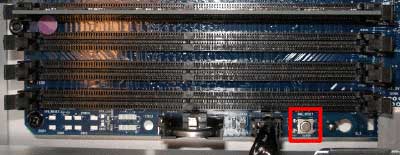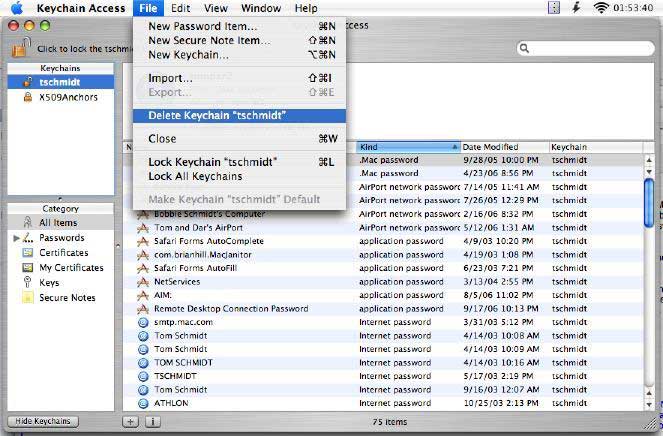
I was listening to the September 11th episode of the This Week in Tech podcast last week, TWiT 68, and not quite half way through I heard Cory Doctorow say some things that kind of surprised me. I expect to hear inaccurate statements from mainstream media, but not from the TWiT übergeeks. They were discussing bit torrent vs. easier solutions like iTunes for downloading media:
Cory Doctorow: “When you do get these things that are slightly milder, although you know still have restrictions downstream, that’s actually in some ways more problematic ’cause you get these people who end up sinking a lot of money into a platform – not realizing how locked in they’re getting. So you know…”
Wil Harris: “Like iTunes?”
CD: “Like iTunes, right. You know, maybe it costs you a hundred bucks to switch (from an iPod) to a Creative device and whose to say that the iPod’s going to be the best one forever. I mean, anyone remember the Quadras or the Performas? You know, Apple has a spotty record here. So you switch to a Creative device in five years. Maybe the device is a 100 bucks, but if you spent 200 bucks on music you’ve tripled the cost of the device because you can’t take your Apple stuff with you.”
They did go on to say that audio capture software, such as Audio Hijack, could be used to re-record the playing songs or that conversion software (which is currently illegal in the US because of the Digital Millennium Copyright Act) could be used to convert the iTunes protected AAC files, but the statement was made by Cory Doctorow that you can’t put iTunes songs on a Windows Media player.
Renowned tech guy Robert Scoble also got it wrong back in January of 2004: “Because if you buy songs off of Apple’s iTunes system, they are protected by the AAC/Fairtunes DRM system, and can’t be moved to other devices that don’t recognize AAC/Fairtunes. Apple has you locked into their system and their devices. (And, vice versa is true, as any Apple fan will gladly point out to you).”
And the WalMart Music Downloads FAQ implies that it’s not possible to put their songs on an iPod: “Q: Can I transfer the music I download to a portable player? A: Yes, you can as long as the player is able to play WMA files (note: iPods currently DO NOT play WMA files). Please refer to the documentation that came with your player to determine if it is compatible with WMA-format music.”
Yes you can put iTunes songs on a Toshiba Gigabeat or a SanDisk Sansa (or any other player), and you can also put Windows Media songs on an iPod. I’ve done it. I got Crazy by Gnarls Barkley from the WalMart music store with a free download code on a pack of batteries, and it’s on my iPod. The solution is 100% legal, although it would be tedious to do it with a large number of songs.
Both iTunes and Windows Media Player 10, which is only available for Windows, allow you to burn audio CDs of purchased songs. Here’s how to put iTunes Store songs on a non-iPod player, and vice versa:
1. Burn purchased songs to an audio CD using iTunes or Windows Media Player.
2. Import CD into Windows Media Player or iTunes as mp3.
3. Put on any digital music player.
Those are the basic steps. The exact details differ based on whether you are using Windows Media Player or iTunes and which music player you have. By default, iTunes imports as AAC. You can change this to mp3 in the Advanced section of the iTunes preferences. It’s that simple.
Our featured letters this month are about a problem with lots of possible causes (a Power Mac G5 with a bad case of insomnia), a common problem caused when resetting your Mac OS X password (the keychain password isn’t changed), and using newer iPods with older Macs.
——————————
InsomniMac G5
Hi Tom,
I heard on the podcast that I could ask a question. I have a Power Mac G5 with a 30 inch Apple Cinema display. I am totally up to date at 10.4.7 with all updates run to the best of my knowledge. Recently, it keeps waking up from sleep by itself a lot. What can I do to fix this? Any help will be appreciated!
Thanks,
Richard
Manhattan Beach, CA
Richard,
This is one of those questions that doesn’t have a nice clean answer. The first thing that needs to be ruled out is software. The Energy Saver & Bluetooth system preferences have some settings that you can adjust. In Bluetooth -> Settings, make sure “Allow Bluetooth devices to wake this computer” is off. In Energy Saver -> Options, make sure “Wake when the modem detects a ring” and “Wake for Ethernet administrator access” are off. You may not see some of these if you do not have Bluetooth or a modem. The final piece to rule out your system software would be to find another startup source, either a second internal hard disk or an external hard disk containing a full installation of Mac OS X. A Mac OS X install disc won’t work for this because the version there isn’t complete. If the problem doesn’t occur started from another disc, then something in Mac OS X is wrong. Either a setting of some sort, a damaged pref file, 3rd party software, or damage to Mac OS X that would require it to be reinstalled.
The second thing that needs to be ruled out is peripherals. With only your keyboard and mouse connected directly to your G5, a different display, and all added PCI cards removed (if any – be sure to use an anti-static pad and wrist strap), does the problem still occur? If not, add back your peripherals one at a time until the problem comes back to find the cause.
If you still have the issue with a different display, keyboard, mouse, and no PCI cards or other peripherals, then it is a hardware problem with your G5. The last thing to try before bringing it in for service is to reset the System Management Unit chip. Find a popsicle stick, chopstick, dowel, or other wood item so you can push the button without risking a static discharge to the logic board. These instructions are from Apple Knowledgebase article 300341:
1. Turn off the computer by selecting Shut Down from the Apple menu or by holding the power button until the computer turns off.
2. Open and remove both the metallic outer door and the inner plastic air deflector.
3. Remove the fan assembly immediately to the left of the processor module.
4. Press the SMU reset button on the logic board.
5. Replace the fan assembly, air deflector, and outer door.
6. Turn on the computer.
The SMU reset button is located underneath the lower bank of system memory slots, as shown below:

If software, peripherals, and an SMU reset do not solve the problem then it is time to bring in your G5 for service. You still have 2 1/2 years left on your AppleCare, so as long as it doesn’t end up being no problem found or a software or configuration issue you are covered. My guess would be the logic board if it is a hardware issue. The best place to bring it would be an Apple Specialist. The technicians at an Apple Specialist are typically more experienced than the Apple retail geniuses. Melrose Mac in Hollywood, CA and mac-fusion in Signal Hills, CA are close to you and would probably provide excellent service. You can find all the Apple Specialists in your area at the Apple Specialist Marketing Co-op web site. Good luck!
——————————
Broken Keychain
Greetings Tom
Recently I wanted to download a new version of QuickTime, but in order to do that I needed to update my system. And in order to do THAT I had to supply my Mac OS X password, which I had forgotten. With the help of a friend, I used the Tiger system CD to reset the password. Unfortunately, I subsequently received a series of popup messages asking me for my ‘keychain access’ password. I have no recollection of ever having such a password, nor had my friend. Her son, usually an authority in these matters, had no idea what to do about it either.
The message goes away after I click ‘cancel’ a few times, but it’s very annoying. Hoping you can help.
Margret RoadKnight
Brisbane, Australia
Margret,
This almost always happens when resetting the Mac OS X password, and is relatively easy to fix. Your keychain is created during the initial setup when your Mac OS X user name & password are created. The keychain remembers all sorts of things for you, so you don’t have to. It keeps track of wireless network passwords, email account passwords, web site passwords you tell Safari to remember, web form data, iChat account passwords, server passwords, and other similar things. It is closely linked to your account login, using the same password. Resetting the Mac OS X password breaks this link, causing the prompts for the keychain password.
The solution is to delete your existing keychain and restart. A new keychain will be created tied to the new password. The downside is that all the stuff in your keychain will need to be reentered, but that will happen as you go along using your computer normally.
First, open the Keychain Access application. It’s in the Utilities folder in your Applications folder. Next, make sure your keychain list is visible. If not, you can show it by clicking on the Show Keychains button in the lower left corner of the Keychain Access window in Mac OS X 10.4 or the Keychains button in the upper right corner in 10.2 or 10.3. Select your keychain (it will either be your short user name or “login”), then choose Delete Keychain “name of keychain” from the File menu. Click the Delete References & Files button, then restart your computer.

New USB 2.0 iPod, Older USB 1.1 Mac
Hi Tom!
I have a question and I was hoping you could help me out. My girlfriend and I have 2nd and 1st generation iPod minis respectively, and we are thinking about upgrading them with the new iPod nanos. The thing is I have a 1GHz 17″ PowerBook G4 and my girlfriend has a 12″ G4 iBook. Neither of those has any USB 2.0 ports. I know I can get a USB 2.0 PC Card for my PowerBook, but the iBook does not have a slot for those cards. Is there some adapter, or converter, or something that I could use on the iBook? It would be great if it could still be done through the FireWire port like the first iPods.
Thanks a million.
Antonio in Panama
Hi Antonio,
A USB 2 PC Card should work for the PowerBook, but sometimes there are compatibility issues with 3rd party USB 2 cards, both with PC Cards and PCI cards for desktop machines. As for the iBook, the nano will work with the USB 1.1 ports. It just won’t sync as fast as USB 2.0 & there is no way to add USB 2 to an iBook. Thanks for writing!
Send your questions to tom@mymac.com. I will personally reply to each message when received and select letters will be included in the MyMac.com Help Desk column.

Leave a Reply
You must be logged in to post a comment.